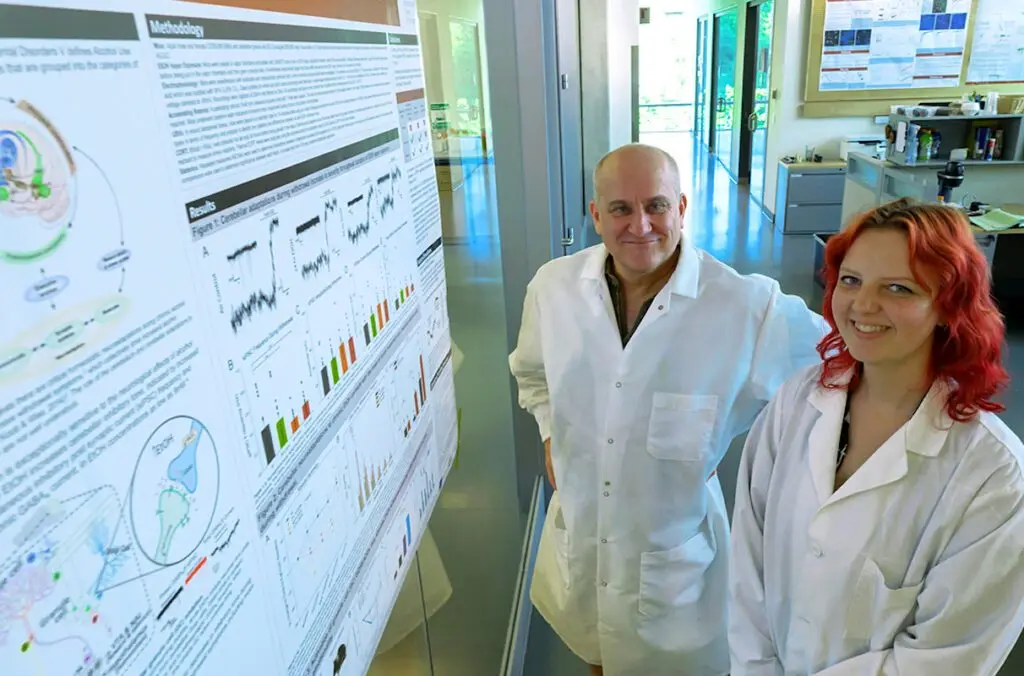PULLMAN, WA – By targeting a specific area of the brain, researchers at Washington State University may now hold the key to curbing the debilitating symptoms of alcohol withdrawal that push many people back to drinking.
The new study found the answer to helping people get through alcohol withdrawal may lie in a region of the brain known as the cerebellum. In mice experiencing withdrawal, scientists were able to ease the physical and emotional symptoms by altering brain function in this brain region using both genetic tools and a specialized compound. The findings, published in the journal Neuropharmacology, could help pave the way for targeted therapies that make recovery more manageable.

“Our research suggests the cerebellum could be a promising therapeutic target to help people get through the most difficult stage of alcohol use disorder,” said Nadia McLean, lead author and doctoral researcher in the Department of Integrative Physiology (IPN). “By targeting the cerebellum, we were able to ease both the physical motor discoordination and the emotional distress of withdrawal — the symptoms that so often drive people back to drinking.”
Alcohol use disorder, or AUD, affects an estimated 29 million Americans. It is the nation’s third-leading preventable cause of death, behind cigarette smoking and obesity. Fewer than one in five people with AUD are able to maintain long-term sobriety, despite a range of available treatments.
Our research suggests the cerebellum could be a promising therapeutic target to help people get through the most difficult stage of alcohol use disorder.
Nadia McLean, doctoral researcher
Department of Integrative Physiology
Washington State University
While much of the research into AUD has focused on the brain’s reward centers, McLean and her colleagues zeroed in on the cerebellum, which has traditionally been associated with movement and coordination.
“Half the neurons in the brain are in the cerebellum,” said David Rossi, the study’s senior author, who is an associate professor in IPN and McLean’s advisor. “It’s increasingly clear this region is involved in far more than just motor control — it plays a role in addiction, emotional regulation and even social engagement.”
Using mice as a model, the researchers found chronic alcohol exposure disrupts the cerebellum’s normal signaling, which essentially becomes rewired to function in the presence of alcohol. Once alcohol is removed, though, the brain enters a hyperactive state, which leads to withdrawal symptoms.
The researchers tested two strategies to counteract withdrawal.
The first strategy used a genetic approach in which the researchers inserted special receptors into cerebellar neurons. When activated, these receptors acted like an “off switch,” calming overactive cerebellar activity during withdrawal and improving motor coordination in mice. While this showed that restoring inhibition in the cerebellum could reduce withdrawal symptoms, the method relied on genetically modifying animals and isn’t currently a realistic option for people.
The second strategy, however, points to a more practical path forward. The team tested a synthetic compound known as Compound 6, developed by chemists in Austria, that targets a receptor found only in the cerebellum. When given to mice in withdrawal, the drug eased emotional distress, or anxiety, without affecting the rest of the brain. It also showed low abuse potential, as mice not in withdrawal found it aversive.
“Compound 6 gave us a way to target the cerebellum without genetic modification,” McLean said. “That makes it a much more realistic option for therapy, and it suggests this part of the brain could be a powerful target for treating alcohol withdrawal.”
While clinical trials are still far off, the research sets the foundation for promising treatment options.
“What makes this approach exciting is that we’re looking at ways to target a very specific brain region and receptor, instead of applying a broad treatment that comes with side effects,” Rossi said. “If we can take away the worst part of withdrawal, even temporarily, people may be better able to succeed with counseling or other long-term treatments for AUD.”





